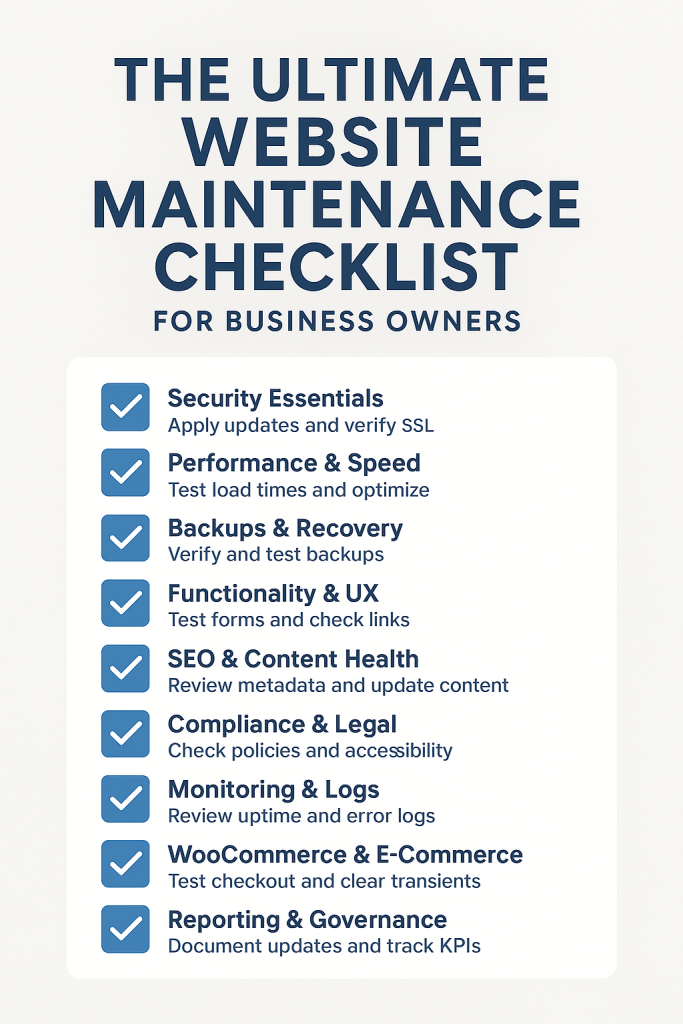Your website is one of your most valuable business assets. It generates leads, processes sales, communicates your brand, and builds trust with customers. But like any asset, it needs consistent upkeep. Without regular maintenance, websites slow down, break, and become vulnerable to hackers — often costing far more to fix than to prevent.
This checklist is designed for business owners who want to keep their websites healthy, secure, and performing at their best. Follow these steps monthly and quarterly, and you’ll avoid costly downtime while keeping your site working for your business, not against it.

1. Security Essentials
Security should always come first. A neglected site is a prime target for attackers, and the consequences of a breach can be devastating.
- Update core, plugins, and themes. Outdated software is the #1 cause of hacks. Apply updates regularly, testing on staging first.
- Remove unused or outdated plugins/themes. Every plugin is a potential vulnerability. Delete what you don’t use.
- Verify SSL certificate validity. That padlock in the browser matters for trust and compliance. Ensure your SSL auto-renews.
- Run malware scans. Security plugins or hosting tools can catch issues before they spread.
- Review user accounts and permissions. Remove inactive accounts, reset passwords, and confirm roles are correct.
- Check file permissions. Restrict editing rights and disable file editing from the admin dashboard.
Pro tip: Even one overlooked plugin update can be the weak point hackers exploit. Make this section a non-negotiable routine.
2. Performance & Speed
Speed matters for both user experience and SEO. Google research shows more than half of users abandon a site that takes longer than 3 seconds to load.
- Test page speed. Use tools like Google PageSpeed Insights or GTmetrix to benchmark performance.
- Optimize images. Compress large files, and consider next-gen formats like WebP.
- Purge caches. Refresh page, object, opcode, and CDN caches regularly.
- Clear and refresh transients. Both WordPress and WooCommerce store temporary data that can pile up and slow things down.
- Optimize database tables. Remove overhead and clean up bloated options tables.
- Review cron events. Make sure scheduled tasks are running and not stuck.
Pro tip: If your site feels slower than it did a year ago, maintenance is overdue. Performance declines gradually, and most owners don’t notice until users start complaining.
3. Backups & Recovery
A good backup is the difference between a minor inconvenience and a business disaster.
- Confirm backups are running. Verify both database and file backups are scheduled.
- Test restores. A backup is only as good as your ability to restore it. Do quarterly restore tests on staging.
- Store backups in multiple locations. Use both offsite cloud storage and local copies.
- Exclude cache folders. Saves storage space and prevents restoring junk data.
Pro tip: Automate backups but verify them. Too many businesses discover their backups have been failing only after a crash.
4. Functionality & User Experience
Broken sites lose business fast. Maintenance isn’t just about what’s under the hood — it’s about making sure your visitors can interact smoothly.
- Test forms. Contact, signup, and checkout forms must submit properly and send notifications.
- Check navigation. Menus, search, and filters should work seamlessly.
- Cross-device test. Review your site on modern iOS and Android devices in different browsers.
- Validate links. Look for 404 errors and broken redirects.
- Delete spam comments. Clear out junk to keep your site tidy and improve performance.
👉 Pro tip: Pretend you’re a customer once a month. Start from the homepage and try to buy a product or book an appointment. Note every friction point.
5. SEO & Content Health
Search visibility isn’t “set it and forget it.” Your content and technical SEO need ongoing checks.
- Review meta titles and descriptions. Fix duplicates and fill in missing fields.
- Update outdated content. Check product descriptions, hours, and service details.
- Add alt text. New images should always have descriptive alt tags.
- Update internal links. Link to new posts and cornerstone content.
- Validate sitemap and robots.txt. Ensure search engines see the latest version.
- Check Google Search Console. Fix coverage issues, mobile errors, and warnings.
👉 Pro tip: SEO maintenance pays compounding dividends. Even small monthly fixes can prevent major ranking losses.
6. Compliance & Legal
Laws and user expectations evolve — your site should too.
- Update privacy policies and cookie banners. Make sure you’re aligned with GDPR, PIPEDA, or other relevant standards.
- Check accessibility. Run basic WCAG checks for contrast, keyboard navigation, and alt tags.
- Review third-party embeds. Ensure analytics, chatbots, and forms respect consent settings.
👉 Pro tip: Accessibility improvements don’t just avoid liability — they improve UX for everyone.
7. Monitoring & Logs
Good maintenance means proactive monitoring, not waiting for customers to complain.
- Enable uptime monitoring. Services like UptimeRobot or Pingdom will alert you immediately if your site goes down.
- Review error logs. Look for recurring PHP or server errors in debug logs.
- Check security plugin logs. Watch for suspicious login attempts or file changes.
- Document issues and fixes. Keep a changelog for reference.
👉 Pro tip: Treat your website like IT infrastructure — because it is. Logs are early warning systems.
8. WooCommerce & E-Commerce (if applicable)
Online stores require extra diligence. Even a small checkout error can mean thousands in lost revenue.
- Test checkout. Run a live or sandbox transaction monthly.
- Verify order emails. Make sure customers and admins get notifications.
- Clear WooCommerce transients. Regenerate product lookup tables as needed.
- Check shipping, tax, and stock rules. Ensure calculations are accurate.
- Monitor renewals. For subscriptions, confirm auto-renewals process correctly.
👉 Pro tip: Always test your checkout after major plugin or theme updates.
9. Reporting & Governance
Finally, treat maintenance as an ongoing process — not random fixes.
- Record KPIs. Track uptime, speed, SEO health, and resolved issues.
- Keep a maintenance log. Document updates, patches, and incidents.
- Review hosting environment. Check PHP versions, database versions, and server performance.
- Audit annually. Do a full review of plugins, themes, and hosting needs.
👉 Pro tip: A consistent paper trail of updates and fixes helps resolve disputes with vendors and demonstrates due diligence.
Suggested Cadence
- Weekly: Backups, spam deletion, error log check, critical updates.
- Monthly: Plugin/theme/core updates, database optimization, forms testing, Search Console review.
- Quarterly: Restore test, content refresh, accessibility/SEO sweep, user role audit.
- Annually: Hosting plan review, policy/legal update, inactive plugin removal.
WP-CLI Cheat-Sheet
Run on staging first; ensure backups are current.
# Delete spam comments
wp comment delete $(wp comment list --status=spam --format=ids) --force
# Clear all WordPress transients
wp transient delete --all
# WooCommerce: clear transients & regenerate product lookup tables
wp wc tool run delete_transients --user=admin
wp wc tool run regenerate_product_lookup_tables --user=admin
# Optimize database tables
wp db optimize
# Review error log (if WP_DEBUG_LOG is on)
tail -n 200 wp-content/debug.log
# List inactive plugins (then deactivate & delete as appropriate)
wp plugin list --status=inactive
Conclusion
A healthy website doesn’t happen by accident — it’s the result of consistent, disciplined maintenance. This checklist covers the essentials, but if you’re like most business owners, you’d rather spend time running your company, not fixing plugins or debugging error logs.
That’s where a Website Care Plan comes in. At iGo Sales and Marketing, we handle all the behind-the-scenes work — security, performance, backups, and monitoring — so you can focus on growing your business.
Don’t wait for a crash or a hack to force your hand. Take control of your website’s future today.

